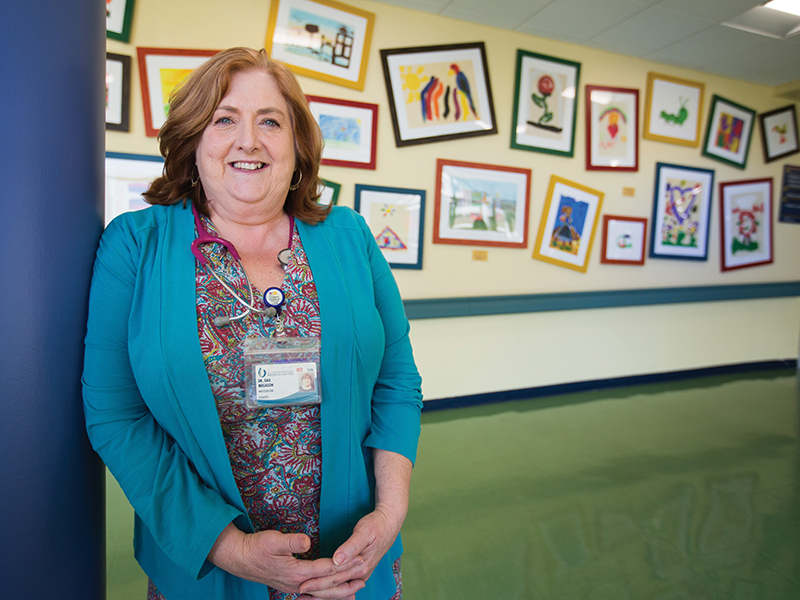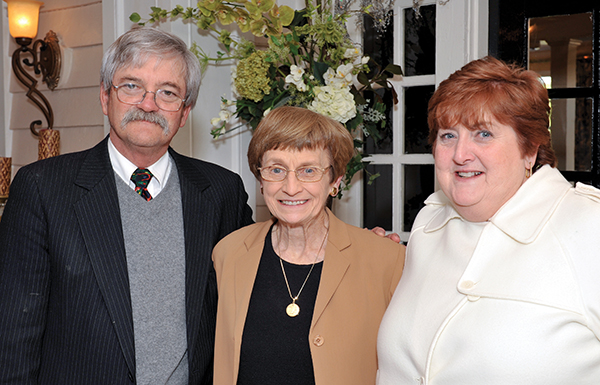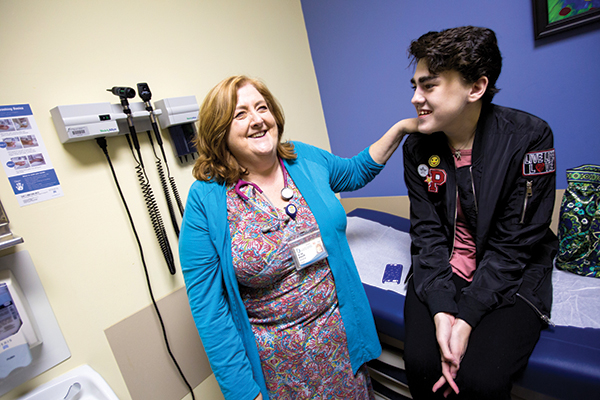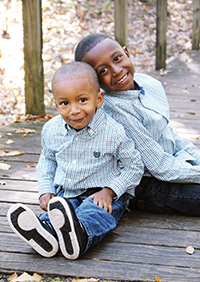Children’s Cancer Center director sleuths to solve disease's mysteries

Published on May 01, 2017
NOTE: This article originally appeared in the Spring 2017 issue of Under the Rainbow, the semi-annual magazine for Batson Children's Hospital/Children's of Mississippi. A PDF of that issue can be found here.

If the bill for services rendered to Christopher Stamps Jr. had been completely accurate, said his father, it would have said his family owed this much to Dr. Gail Megason: “Everything.”
Anyway, that's the view of Christopher Stamps Sr., whose older son, now 7, is free of the pain, swelling, vision problems, infections and more associated with sickle cell anemia, thanks to the skills of the Children's Cancer Center team led by Megason, professor of pediatrics and clinic director.
“This hospital, this state and these children are fortunate to have her,” Stamps said.
The Department of Pediatrics, which includes the Division of Pediatric Hematology/Oncology, has had Megason since her return to the Medical Center in 1994; from that point on, the department has recorded about 200 pediatric bone marrow transplants; that number for 2016 alone was 10.
Because Megason and her team make a living pursuing and foiling a killer, it should surprise no one that the Gulfport native fills some of her spare time absorbing murder mysteries and tracking down antiques - mostly for the challenge of the hunt.
More surprising, possibly, is the fact that the woman who works so hard to fight cancer in young patients had once vowed she would never be a pediatrician.
The great equalizer

In this December 2010 photo, Dr. Owen B. Evans, then-chair of the Department of Pediatrics, visits with Dr. Jeanette Pullen, center, professor emeritus of pediatrics, and Megason.
She was born in Gulfport, but her military family also made temporary homes in, among other places, Idaho, Texas, Michigan's Upper Peninsula, and even Europe.
Still, she is a child of the Gulf Coast, an alumnus of Gulfport East - the former name of Gulfport High School - and frequent visitor to Mississippi's shore, where many of her aspirations were born as well, including her desire to become a physician.
That ambition was also influenced by the career choice of her older brother, Dr. William Owen, now a psychiatrist in Laurel.
“He told me, 'If I had been a Roto-Rooter Man, you would be one, too,'” she recalled.
But during her freshman year at Mississippi College, she was “sidetracked,” she said, by love. She married, moved to Germany and had a daughter named Candy.
Later, back in the United States, she started her life over as a single mom. Alone with a child, she “lacked the confidence” it takes to apply to medical school, she said.
Instead, at the University of Southern Mississippi, she enrolled in nursing school, where her organic chemistry professor pulled her aside and suggested that her original dream did not deserve to die.
Encouraged, she started her first year of medical school the year her daughter started first grade. “Medical school is the great equalizer,” Megason said. “Everyone there is smart. But when you're young, you think you can do anything.”
She did it, of course, helped along by her parents, who supported her; a fellow medical student, who sometimes babysat for her; and her daughter, who occasionally labored outside the Gross Anatomy Lab on her math and English homework, deconstructing or classifying her subject, while, inside the lab, her mother did the same.
That early exposure to medical school ambience did not color too much the career choice of Candy Jones, now 40. On the other hand, as an accountant, she is working in a profession that, like her mother's, was dominated by men not so long ago.
Even then, when Megason finished medical school, in 1985, “women were supposed to be pediatricians,” she said. “And I was going to break that stereotype.”
In love again

Megason shares a laugh with patient Sydney Holifield of Laurel.
On her first rotation in medical school, she met a group of people known for healing themselves. They are resilient, and beyond long-suffering, she said.
“They will let you do terrible things to them and then hug your neck.” They are children.
That first rotation was in pediatrics. “And I fell in love with it,” she said.
The would-be pathologist changed her mind about becoming a pediatrician. In fact, over the years, she became ever more engaged in the specialty, at one point serving for 10 years as the residency program director in pediatrics.
“I saw those residents change when they became parents themselves,” she said. “They saw the parents' side of things as well; you can appreciate the angst parents have.
“It's amazing how much better pediatricians they are once they have children.”
For her part, Megason expanded her practice above “runny noses and obesity.” Her decision to take on hematology/oncology - treating cancer and blood disorders - was personal; it was about family.
Her mother-in-law had been diagnosed with a blood disorder that portends cancer. She eventually died of the disease, but Megason had been inspired by the skills of Dr. Joe Files, now a professor emeritus who directed the Division of Hematology at the time.
She was also swayed by the work of several other physicians she admired, including Dr. Jeanette Pullen, also a current professor emeritus, who was leading pediatric hematology then.
Megason eventually inherited Pullen's job and, in a way, her name. Today, she is the Jeanette D. Pullen Endowed Professor of Pediatrics Executive Vice Chair and is the director of pediatric hematology/oncology.
“I spent my young, formative faculty years under her direction,” Megason said. “When she retired (in 2005), I said I didn't want the job; her shoes were too big to fill.
“But she's been fabulous. She's always available to give me advice when I ask for it.”
Pullen, who is actually partially retired, praised Megason's training - including a six-month visiting professorship in bone marrow transplant at Seattle's Fred Hutchinson Cancer Research Center in 1994.
This expertise enabled Megason and her staff to give new life, so far, to 16 sickle cell anemia patients through bone marrow transplants, the only known cure for the disease.
“She's very conscientious,” Pullen said, describing Megason as a leader and physician. “She has a good sense of humor, and one needs that.
“You follow families for a long time in this work. That makes it even harder when a child doesn't make it. But you feel that you've helped them through it. And now, the overall cure rate is 85 percent for ALL (acute lymphoblastic leukemia, the most prevalent type of leukemia among children), and greater than 95 percent for low-risk patients.
“So, many do better who wouldn't have not so long ago.”
Pediatric oncologists do have a lot of successes these days, said Dr. Rick Barr, professor and chair of the Department of Pediatrics.
“They are also special people; they realize that even when patients don't survive, they make a difference. They make a difference as far as how these children live out their lives.”
Blood brothers

In August 2015, Cameron Stamps, left, now 2 and a half, shared his bone marrow with his brother, Christopher Stamps, now 7.
Soon after completing her residency, Megason entered private practice, where she encountered a world of office politics and occasional personality clashes.
“Lord, I just wanted to take care of children,” she said.
After leaving that practice, she returned to the Medical Center and Batson Children's Hospital, where she has been able to treat the children who need her most, such as Christopher Stamps.
Born with sickle cell anemia, a painful blood disorder that disproportionately attacks African Americans, Christopher endured the disease for five years as his family searched in vain for a donor match. They found him when Christopher's brother Cameron was born, in July 2014.
But, not until after his first birthday would Cameron be old enough to face the rigors of the bone marrow harvest. So, in the late summer of 2015, Christopher, now 6, got his transplant.
“It changed my son's life forever,” said Latasha Pusha Stamps, mother of the two boys. “Now, Christopher has a chance to be a regular child; he's able to participate in sports, and we don't have to be worried about him being around other children and getting sick.
“And through it all, Dr. Megason was kind and understanding; she took the time to explain things to us. Our concerns were not brushed off. She has a very good spirit about her. You trust her.”
This approachability makes her a good physician and leader, Barr said. “She's a plain speaker, a straight talker; and that's refreshing.
“She's also laser-focused. Every time I talk with her, she brings it back to one thing: how to better take care of kids with cancer.”
Megason's compassion extends beyond the boundaries of the Medical Center and outside her regular schedule. She has directed and helped raise money for Camp Rainbow, the five-day summer getaway for children with cancer and for those who have survived it.
She has been a force for Candlelighters, which offers comfort and support for the families of children who have been diagnosed with cancer.
Among the most memorable for her is Mark Ely, whose cancer was detected when he was a month shy of his third birthday. He was nearly 16 when he died, but his mom remains active in supporting the work of Children's of Mississippi, Megason said.
“It was a long, hard time for her. But we are family for many of these parents. Other people don't know what to say, and don't bring it up.
“It may be 15 years after the death of their children, but they know they can come here and hug our neck and tell stories. We remember their children with them, because they don't want anybody to forget.”


